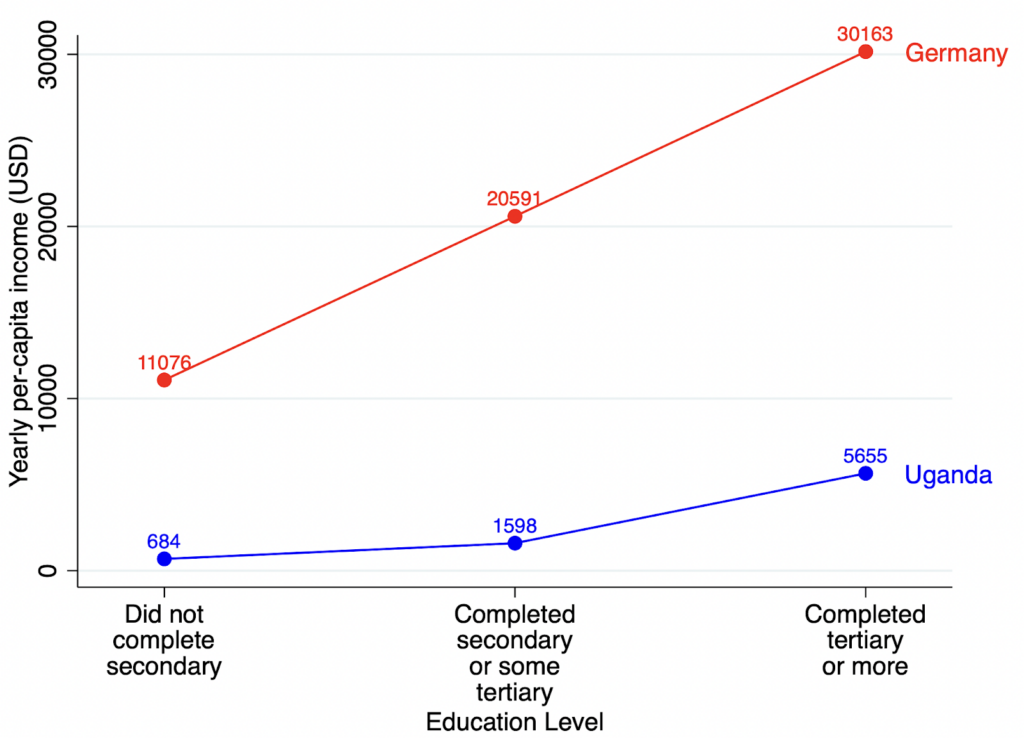We are grateful for donations! Donations are tax-exempt in the United States, where Malengo is a 501(c)(3) charity; and in Germany, where Malengo is a non-profit LLC (gGmbH).
If you have questions about donating, or would like to discuss other ways to get involved, please contact Johannes Haushofer [email protected]
Select Payment Method:
Send a check
Malengo Inc.
8 The Green, Ste. 4000
Dover, DE 19901
Transfer to our US account
Please contact us for account details: [email protected]
Transfer to our German account
Malengo gGmbH
Rosenthaler Straße 43-45
10178 Berlin
Germany
Research on International Educational Migration
What are the returns to migration?
The basic thesis of Malengo is that international educational migration is one of the most powerful tools for poverty alleviation (Clemens,2010).
Figure 1, below, shows suggestive correlational evidence in support of this claim: Individuals aged 25–30 in Germany with at least a BA degree earn 19 times more than Ugandans in the same age group with a high school degree.

Figure 1 shows suggestive correlational evidence in support of this claim: Individuals aged 25–30 in Germany with at least a BA degree earn 19 times more than Ugandans in the same age group with a high school degree.

Of course such correlational evidence does not yet imply a causal effect of educational migration on income. However, studies that permit such causal claims have shown that international migration generates income increases of several hundreds of percent (McKenzie, Stillman, and Gibson 2010).
In addition, education itself has large returns, on the order of 10% per year (Peet, Fink, and Fawzi 2015). Importantly, these returns are unlikely to decay over time. This is in sharp contrast to e.g. cash transfer programs, whose effects have been shown to become much smaller over time (Blattman, Fiala, and Martinez 2020).
In addition, educational migration is likely to have a “brain gain” effect on the country of origin: partly because migrants send back remittances; and perhaps more importantly, because siblings and other young people in the home community now have increased incentives to invest in their own education (Batista, Lacuesta, and Vicente 2012). In addition, it has been shown that migration causes firms in the target country to engage in foreign direct investment with the country of origin (Burchardi, Chaney, and Hassan 2019). Thus, international education migration might create an important multiplier effect which not only benefits the target students, but also the home community and country of origin.
Finally, educational migration has benefits for the target country: Germany, like many high-income countries, faces an aging population, and is therefore actively trying to attract students from abroad and issues student visas liberally.
Migration intentions
Do people actually want to migrate to a different country? The answer is: not everybody, but quite many in low-income countries, especially Sub-Saharan Africa. Below is a map that illustrates this, using data from the Gallup World Poll:
In Uganda, 36 percent of people answer “Yes” to the question “Ideally, if you could afford it, would you like to move permanently to another country?”. Amongst young people under 25, the figure is 50%.
How many Ugandans are qualified to study in Germany?
In 2020, there were 9,585,429 people aged 15–24 in Uganda, for a cohort size of roughly 958,543 (Our World in Data).
In 2020, 98,392 students (41.9% women) took the examination for the Uganda Advanced Certificate of Education (The Observer, 2021). Of these, 68,622 (69.7%) obtained high enough grades to qualify for university entry in Germany (two “principal passes”). Relative to a cohort of 958,542, this is a share of 7.2%. The share of women in this group is 44.7%.
References
Batista, Catia, Aitor Lacuesta, and Pedro C. Vicente. 2012. “Testing the ‘Brain Gain’ Hypothesis: Micro Evidence from Cape Verde.” Journal of Development Economics 97 (1): 32–45.
Blattman, Christopher, Nathan Fiala, and Sebastian Martinez. 2020. “The Long Term Impacts of Grants on Poverty: 9-Year Evidence from Uganda’s Youth Opportunities Program.” American Economic Review: Insights 2 (3): 287–304.
Burchardi, Konrad B, Thomas Chaney, and Tarek A Hassan. 2019. “Migrants, Ancestors, and Foreign Investments.” The Review of Economic Studies 86 (4): 1448–86.
Clemens, Michael A. 2011. “Economics and Emigration: Trillion-Dollar Bills on the Sidewalk?” Journal of Economic Perspectives 25 (3): 83–106.
Gibson, John, and David McKenzie. 2011. “Eight Questions about Brain Drain.” Journal of Economic Perspectives 25 (3): 107–28.
References
Batista, Catia, Aitor Lacuesta, and Pedro C. Vicente. 2012. “Testing the ‘Brain Gain’ Hypothesis: Micro Evidence from Cape Verde.” Journal of Development Economics 97 (1): 32–45.
Blattman, Christopher, Nathan Fiala, and Sebastian Martinez. 2020. “The Long Term Impacts of Grants on Poverty: 9-Year Evidence from Uganda’s Youth Opportunities Program.” American Economic Review: Insights 2 (3): 287–304.
Burchardi, Konrad B, Thomas Chaney, and Tarek A Hassan. 2019. “Migrants, Ancestors, and Foreign Investments.” The Review of Economic Studies 86 (4): 1448–86.
Clemens, Michael A. 2011. “Economics and Emigration: Trillion-Dollar Bills on the Sidewalk?” Journal of Economic Perspectives 25 (3): 83–106.
Gibson, John, and David McKenzie. 2011. “Eight Questions about Brain Drain.” Journal of Economic Perspectives 25 (3): 107–28.
Lorem ipsum dolor sit amet, consectetuer adipiscing elit aenean comm odo ligula eget dolor massa Lorem ipsum dolor sit amet, consectetur adipiscing elit. Aenean egestas magna at porttitor vehicula nullam.
- Choose your favourite cause
- Register to our website !
- Donate the amount you like
- Stay tuned about cause





